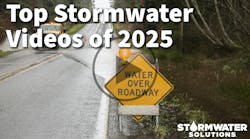About the author: Caitlin Cunningham is managing editor of Storm Water Solutions. Cunningham can be reached at 847.391.1025 or by e-mail at [email protected].
Related search terms from www.waterinfolink.com: outreach, education, community
Due in great part to the modern lifestyle and activities of man, storm water runoff today contributes more significantly to U.S. water pollution than any other factor. Sprawling development, squeaky-clean cars, lush golf courses—if proper precautions are not taken, endeavors like these leave ground contaminants behind to wash into receiving waters. Fortunately, a bit of education and involvement can go a long way in changing the general public’s storm water-related habits and attitudes.
Start Strong
A solid support system is the foundation of any effective and far-reaching storm water public outreach program. From the beginning and down the road, collaborating to achieve mutual goals can help in terms of funding, information resources, audience relationships and more.
Tracy Schubert, public outreach manager for 3 Rivers Wet Weather (3RWW), Allegheny County, Pa., recognizes the importance of partnerships. In fact, the nonprofit environmental organization was created in 1998 as the result of coordination and cooperation between the Allegheny County Health Department and the public works agency ALCOSAN.
In 2001, 3RWW launched its public outreach program, which in a rainy, hilly region with deteriorating sewer lines, continues its tradition of collaboration today. The group provides financial support, data and advocacy to address untreated overflows in its sewage treatment service area’s 83 communities—all of which are under U.S. Environmental Protection Agency (EPA) consent orders.
Opening the lines of communication began with reaching out to municipal officials. 3RWW divided the municipalities into three basins and began meeting with appointed representatives to address territorial feelings of accountability and acclimate participants to the idea of sharing resources and ideas.
“The consensus-building process was very important,” Schubert said. “That was the audience we needed to get on board as a starting point. Then we transferred to meeting with managers and engineers in 2004.”
Only once this foundation was established did 3RWW shift its focus to reaching out to the general public specifically and making residents aware of local storm water issues and activities.
“People don’t necessarily know that if they can’t see a body of water out their windows, that doesn’t mean they’re not affecting them,” Schubert said.
Take for instance a formal survey 3RWW conducted recently with 600 Pittsburgh-area residents. When asked if they knew what a watershed was, 57 percent of respondents indicated that they did. The next question asked whether the respondent lived in a watershed, and only 21 percent said yes.
“We realized our efforts needed to go to as basic a level as possible,” Schubert said.
Get Creative
Basic-level, budget-limited outreach does not have to be synonymous with boring outreach.
For example, with support from the Arts Education Collaborative, Carnegie Museum of Art and educational boat tour provider RiverQuest, 3RWW participates in the nonprofit program River of Words, which encourages schoolchildren to connect with watersheds and express their appreciation via art and poetry. This program presents science and art teachers with a unique opportunity to lead cross-curricular activities, and it encourages young people to develop an understanding of and respect for water resources. The poems and artwork of Allegheny County students participating in River of Words have been displayed at the annual Three Rivers Arts Festival.
“I highly recommend other programs seek out ways to make greater use of the resources they already have,” Schubert said. “Time and money are, for most programs, very real issues, and this approach can really help.”
Similarly, 3RWW is looking to make greater use of its high-tech countywide rain gauge system. The group’s 33 rain gauges possess the power of more than 2,000 ordinary devices, according to Schubert. That being the case, the group is building working relationships with local meteorologists—providing access to its user-friendly technology and data in exchange for storm water-related media and education support.
Advertising has also played a pivotal role in 3RWW’s campaign. The group created a series of ads bearing messages such as “Guess where you’re really putting your lawn fertilizer” and has distributed poster and postcard versions to local community leaders. The outreach program has encouraged recipients to use its uncopyrighted ad, newsletter and brochure materials freely.
The EPA is another excellent resource for outreach materials. To access its customizable, printer-ready documents and related references, visit http://cfpub.epa.gov/npdes/stormwatermonth.cfm.
Follow Up
Making the most of outreach efforts involves regular maintenance and informed action. 3RWW conducts focus groups with municipality managers and hosts an annual sewer conference. At the 2008 event, the group distributed a survey on community needs. By posing questions about available resources, levels of community understanding and communication preferences, the 3RWW staff can review responses and tailor supporting efforts accordingly.
“It’s the baby steps,” Schubert concluded. “It’s important to break the outreach program into small pieces and try to come up with tools that communities can use to their own advantage.”
SIDEBAR
Outreach Model
More tools and tips for making an impact
“Population growth, drought, aging infrastructure, environmental concerns and a weakening economy are just a few of the many challenges that confront us today,” said Joe Chaplin, storm water quality specialist for the city of Loveland, Colo.
To help overcome these difficulties, Chaplin and his colleagues have implemented various public outreach programs, inviting Loveland residents to become key players in the city’s storm water solutions. These efforts include:
Storm water website. The city of Loveland website, www.ci.loveland.co.us, links visitors to the Public Works Department and from there, various storm water-related pages, including one pertaining specifically to its storm water quality program.
Storm drain marker initiative. Volunteers install city-developed markers next to Loveland’s storm drain inlets.
Adopt-a-Waterway program. Similar to the well-established Adopt-a-Highway program, Loveland’s Adopt-a-Waterway counterpart invites groups to maintain designated portions of area water bodies (i.e., removing litter, monitoring water quality and stabilizing eroding streambanks). The city provides and installs signs recognizing adopters’ achievements.
Annual cleanup events. Each spring, Adopt-a-Waterway groups and volunteers pick up trash and debris in and along city water bodies. Each fall, participants set out to do the same, this time focusing specifically on the Big Thompson River.
Loveland residents and business owners have responded positively to these programs, according to Chaplin. He offers the following advice to other municipalities developing or refining a public education and involvement campaign:
- Focus marketing efforts on the correlation between urban life and development affecting water quality;
- Focus on the destination of the storm drains into local waterways and the “untreated” status of storm water;
- Keep messaging simple and understandable to an audience unfamiliar with the topic;
- Clarify what storm water is;
- Explain the household behaviors that impact water quality; and
- Include photos, which will communicate more quickly than copy.
Download: Here

